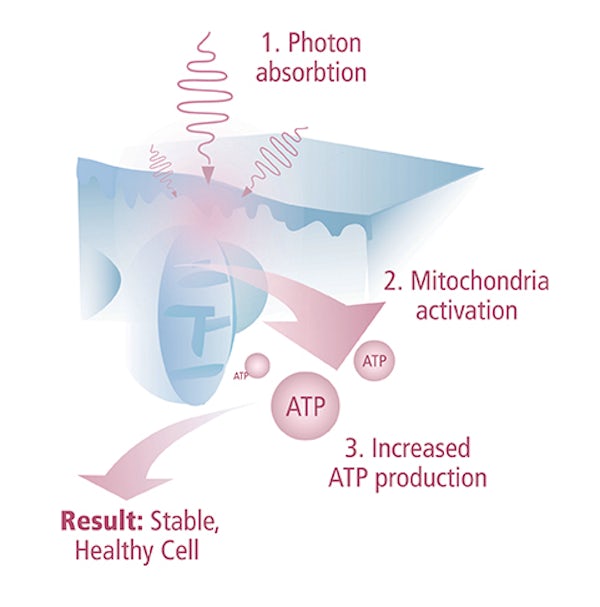Biological Effects of Cold Laser Therapy/Low Level laser Therapy
Low Level Laser Therapy (LLLT) is a special type of laser that emits light particles known as photons to penetrate deeply into the tissue through non-thermal means, this means that no heat is applied to the skin. LLLT is applied to the skin to reduce inflammation, relieve pain and to generate a tissue regeneration response. The reason why LLLT is termed “low level” is because when compared to other forms of laser, the optimum levels of energy density delivered are low.

Mitochondrial respiration and ATP
Humans are composed of trillions of cells. Cells are the basic building blocks of all living things. Within the cell, there are different organelles that have different functions and each perform a different task. One of these organelles is a mitochondria, which acts as the power house for the cell. Its function is to convert oxygen and nutrients into ATP which can be thought of as the fuel that powers the cells. Current research about the mechanism of LLLT involves mitochondria. Mitochondria contain membrane proteins (Cox and CuA) that facilitate the transfer of electrons into oxygen and plays an important role in the bioenergetics of a cell. The absorption of photons by Cox produces electrically excited states, which can subsequently lead to a faster electron transfer reaction which in turn means an increase in the production of ATP. This light induced increase in ATP synthesis leads to increased activity within the cells by various antiporters and pumps. Ultimately, ATP levels controls the level of Ca2+ and cAMP within the cells, which are both very important second messengers. Ca2+ has an important regulatory role in the human body and affects almost every process including; muscle contraction, blood coagulation, signal transfer in nerves and many more. Therefore, by activating various terminal enzymes, like Cox, which play a vital role in the activation of the diverse biological cascade which is observed subsequently to laser irradiation.
Nitric Oxide and LLLT
Nitric oxide affects Cox by inhibiting its activity, however, its effects are reversible by laser irradiation. The bond between Cox and NO is much weaker than a covalent bond therefore, this dissociation is by possible by LLL and works by dissociating NO from its binding site which in turn increases respiration rate. Furthermore, LLL also has a role in protecting cells from Nitric Oxide-induced cell death.
Reactive oxygen species (ROS)
LLLT has been reported to increase ROS generation and cell redox activity which has been proposed to regulate cellular signalling pathways that control gene expression. Nuclear factor B (NF-B) is a transcription factor regulating expression of numerous genes and has been shown to manage various cellular functions, including inflammatory and stress-induced responses. ROS can both activate NF-kB directly and indirectly.
LLL and Gene Expression
Upon the use of irradiation on gene expression profiles of human fibroblasts, it was shown that low level laser can affect the expression of many different genes that have different functions. LLLT enhances and stimulates cell growth directly and indirectly through regulation of expression of genes through a number of different mechanisms. Directly related to cell proliferation and indirectly related to cell migration and remodelling, DNA synthesis and repair, ion channel and membrane potential, and cell metabolism. Additionally, cell proliferation can further be enhanced by irradiation by red light, by supressing cell apoptosis.
Usage of LLLT for Temporomandibular disorders
One of the most significant causes of facial pain has been recognized to be caused from temporomandibular disorders (TMDs). Low level laser therapy (LLLT) is a non-invasive, fast and safe intervention that has been proven to have pain relieving and anti-inflammatory effects on TMD facial pain.
Summary
Low level laser therapy works through molecular and cellular mechanisms driven by the mitochondria which absorb photons, stimulate more ATP production and low levels of ROS. Consequently, activating transcription factors to induce gene transcript products which are responsible for the beneficial effects of LLLT. ROS are recognized for their stimulation of cellular proliferation at low levels and inhibition of proliferation at high levels. Furthermore, Nitric oxide is also recognized in LLLT as beneficial in low amounts by low dose light by releasing from its binding site in the respiratory chain. Further studies will continue to advance in providing understanding for biological mechanisms of LLLT and these advances will lead to LLLT being used for serious diseases such as stroke, heart attack and degenerative brain diseases.